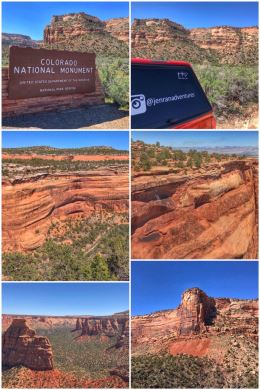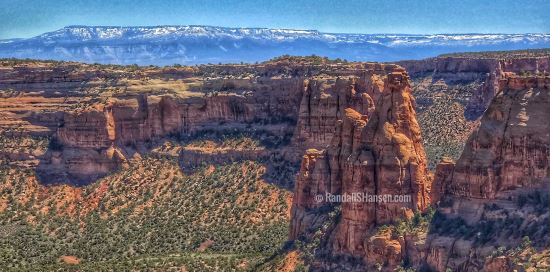
Grand Junction, also known as River City, is located at the confluence of the Colorado and Gunnison rivers, in northwestern Colorado, in an area known as the Western Slope. (While the area is indeed pretty grand, the name actually comes from when the Upper Colorado River was Named the Grand River.)
The Grand Valley area was also once full of fruit tree orchards — apple, peach, cherry, pears — and while some still exist today, grape-growing has become a major agricultural force. In fact, most of the grapes grown and used for commercial wine production in the state come from the Grand Valley, which has the most temperate climate within the state. Happily for us, many wineries are located in the Grand Valley.
But before jumping deeper into wines and wine-tasting, we started our adventures with a trip up to the Colorado National Monument, which offers beautiful vistas, deep canyons with steep walls, and crazy, cool rock formations… preserving “one of the grand landscapes of the American West.” The National Park Service manages this amazing 20,500-acre national monument (and collects a hefty entrance fee). It was established in 1911 by President William Taft to protect its “extraordinary examples of weathering and erosion.” It is the oldest national monument in Colorado. (Fun fact: the Wheeler Geologic Area in the southern part of the state was Colorado’s first national monument, but it was re-designated in 1950 and is now part of the La Garita Wilderness within the Rio Grande National Forest.) As is often the case, the Colorado National Monument owes its existence partly to one person, John Otto, who fell in love with the area and spent years campaigning for it to set aside as a national park. This park quickly became one of our favorite national monuments.

We started our visit on the north end of the park, which is where the visitor center is located. We watched two films about the park and the park’s geology — and we were once again blown away by the number of ancient seas and lakes that helped shape the park… along with the great Rocky Mountain uplift. (Another fun fact: an older mountain range that formed 300 million years ago — which got slowly eroded away and disappeared — was reformed into the Rocky Mountains.) The park is part of the greater Colorado Plateau, which also includes the Grand Canyon, Arches, and Canyonlands national parks.
When atop the plateaus of the park, at more than 2,000 feet above the floor of the Grand Valley, you have some wonderful vistas of Grand Junction and beyond… but it is the canyons themselves that draw the eyes of visitors… with their beautiful colors and crazy rock formations — as well as the sheer cliff walls.
We drove the entire length of Rim Rock Drive, stopping at multiple overlooks and trails, before exiting at the south entrance and back into Grand Junction. The Upper Ute Canyon View is a must-stop because you can shout into the canyon and hear your voice echoed back to you. So fun!
In terms of hikes, we did several… including the Canyon Rim Trail (about 1-mile RT), Window Rock Trail (.5-miles RT), Alcove Nature Trail (1-mile RT), and part of the CCC Trail (in honor of those Civilian Conservation Corps men who helped build the park).

We ended the day with a bit of wine-tasting, starting with Two Rivers Winery, which is located just outside the northern end of the park. The winery is beautiful, and includes a chateau (offering upscale lodging) that is used for meetings, events, and receptions. We had a great tasting with a friendly server, but wondered if they spent too much money on the infrastructure and not enough on the wine production; the wines were okay, but we found most of them had an unappealing tart finish. From there, we headed into the Grand Valley and Carlson Vineyards, one of the oldest commercial wineries in the state — but also fairly recently under new ownership. The tasting room is quaint (a historic fruit-packing shed) and they have a beautiful backyard patio. We enjoyed several of their wines — but were more impressed that they donated part of the sales of several of their wines to local charities. We left with two bottles — one Exodus and one NSFW Red. We ended our tasting at Hermosa Vineyards, “dedicated to hand crafting the finest wine from grapes grown in the high mountain desert of western Colorado.” We enjoyed both the wine and the conversation with the owner and winemaker, Kenneth Dunn. Jen tasted the entire selection of wines, while Ran stuck with the reds. In all three wineries, we found the Merlot with that same tart finish… but we left with a bottle of Cabernet Franc and Cabernet Sauvignon — and a surprisingly wonderful bottle of Cherry Port; it tastes like cherry pie in a bottle (with a nice zing).

We ended our visit to the area with a leisurely hike along the Colorado River Trail, using the Junior Service League Park (just off Redlands Parkway) as our starting point. This section of the trail is called the Blue Heron Section — and we actually did see one of those beautiful birds along the hike.
The trail system currently has five sections — but the goal is to create an uninterrupted public trail system from Palisade (east of Grand Junction) to Fruita (west of the city), following along the Colorado River. The trail also currently connects to the James M. Robb – Colorado River State Park, which offers camping, picnicking, hiking, and water sports.
We thoroughly enjoyed our time in Grand Junction. It is a sizable city (about 62,000 population), but easily navigated — and the natural beauty and wineries and fruit stands are a big draw. The area has also become big for mountain biking (though Moab, Utah, is still the mountain biking mecca).
From here, we begin our trek eastward back over the Rocky Mountains… on our way to Rocky Mountain National Park.
